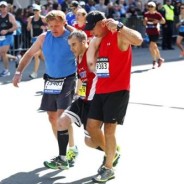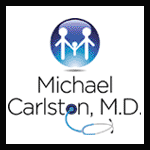
As many of you know, I often volunteer at endurance events, especially marathons. My wife, as well as she knows me, still doesn’t fully understand why I like to do that. That must be because she sees me staggering and bleary-eyed at the end of the races. She asked me about this before I traveled to Boston, which then sent me on the journey thinking a great deal about her question as events transpired. As I reached the answers for her, I also found some insights pertinent to your health.
There are many reasons I like to be involved. Most are centered around learning from these unique experiences, the camaraderie of the event and maintaining at least some peripheral involvement in athletic competition. If I can no longer reach for the same sort of athletic achievements, I can still help others as they reach for their own, or help them recover safely. Endurance athletes can appear to be self-centered narcissists. But from Boston, I realized that, at the most fundamental level, it is all about community. The importance of community for the wellbeing of all of us really shone through.
Any endurance event is a big deal for the participants, because of the work they put into it long before the race. Usually an individual’s performance on the day is the realization of a very long term goal. A teensy percentage of the runners are there with even the slightest chance of winning. The winners are immortalized but every runner is a hero on that day. The event is special personally and communally.
The Boston Marathon is uniquely special. The Boston Marathon is unique because it IS THE BOSTON marathon. Not only is Boston the most prestigious marathon, it is the oldest annual marathon in the world (2014 was the 118th). Any marathon runner, anywhere in the world, dreams of someday running Boston, overcoming Heartbreak Hill and the finish on Boylston Street.
Most marathons draw modest crowds along the 26.2 mile route. The Boston Marathon takes place on a state holiday (Patriot’s Day) and has deep roots in the community. The Red Sox traditionally have a game the morning of the race and, at the end of the game, the baseball fans walk to the marathon route to cheer on the runners. Towns along the way have their own special celebrations, including the “Scream Tunnel” and “Kiss me” signs at Wellesley College. The crowd at Boston is huge, typically over 500,000. This year, a very special year, of course, the crowd was estimated at over 1 million.
The community support and general identification with the runners and the event is unlike anything I have experienced. The 2012 Olympic Trials in the friendly city of Houston paled in comparison. On the plane from SFO, after the Bostonian seated next to me learned that I was a medical volunteer, I received the first of an uncountable number of thanks for my support.
Two nights before the race I had dinner with a colleague from long ago when I started a group on alternative medicine in the Society of Teachers of Family Medicine. As we said good bye on the street by my hotel we were accosted by two very large, intoxicated and threatening homeless men. She immediately knew the right thing to say “He is here to help with the marathon”. They then told me how cool my hat was and left us alone.
The day before the race I was invited to the home of friends I have known for decades. I first met her father who ran one of the old homeopathic pharmaceutical manufacturers about 40 years ago. A little girl then, she has taken over the family company. Every year she and her husband host a party celebrating the Marathon. Again, I spent a good deal of the afternoon accepting the thanks of the runners and their families. I hadn’t done anything yet, but thanks.
Many athletes stayed in my hotel. I was most impressed by the wheelchair athletes. Their “chairs” more more like dragster chariots, long and triangular. When I rode the elevators with them they had to flip up the long end of the chair to fit into the elevator. To my eye the wheelchair athletes looked like the fittest people I saw anywhere on my trip. I was truly in awe.
The day of the race, like any other, volunteers have to arrive very early for our final preparations, sorting out the inevitable last minute kerfuffles. The spirit of the group was very strong. In his preparatory comments, my friend, Chris Troyanos, the co-medical director of the race for decades and said to the group, “Vice President Biden last week said that on race day we take back the finish line. With all due respect to the Vice President, we never gave up the finish line”. In response, the group of close to 1,000 volunteers rose as one and gave him a standing ovation that went on for some time. That was the most dramatic outpouring of the all-pervasive determination I saw everywhere in Boston. Sure, there were all kinds of memorials on the streets, and the security presence was remarkable, but the mood was NEVER somber or fearful anywhere.
The security agencies deserve special praise. Their role is to be suspicious. That can make them difficult. (As I have to cross their lines of authority, I often encounter some sort of understandable incivility on their part). That was never the case in Boston. Even when the police made us vacate the huge medical tent so they could search it with their dog teams, after we had gotten things all set up in anticipation of the onslaught of injured runners, everything went very smoothly.
During the race the teamwork in the medical tent was fantastic. With about 150 MDs (probably 80 in Tent A where I was) and maybe three times as many nurses, physical therapists, athletic trainers and scribes (few of whom knew each other the day before that morning), organization is vitally important in such stress filled chaos. When problems arose, as they always do, the teams dealt with the issues effectively and respectfully.
I had promised not to miss my flight to JFK and my rendezvouswith Melanie. When a gridlocked city and a fight between my cabbie and the women sharing my cab made getting out of Boston seem hopeless, a runner from Georgia bailed me out. He was barely able to walk after the race, but he helped me navigate the nearly paralyzed subway with my big suitcases and make connections to the airport. As Blanche DuBois said, (well, sort of) “We all depend on the kindness of strangers”.
What does all of this have to do with you and your physical training? Or, me and my physical training? We don’t have a million people cheering and media watching from all over the world. Some, but not many of us are working to achieve such high profile goals. Not so much? Actually, there are many lessons each of us can apply to better our health.
- First, each of us can and must have our individual goals. A marathon is an excellent model for that wisdom. How are YOU? What do YOU need to do? Determine immediate steps that lead to larger, long-term goals.
- Good health habits are important no matter what your limitations.
- Teamwork is vital. We can accomplish much more together than we can by ourselves. Support each other’s efforts without criticizing or demeaning. Help each other by being positive.
- Things WILL go wrong. Make your best plans, do your best and prepare for the unexpected.
Resilience is powerful! Community resilience is unstoppable!
